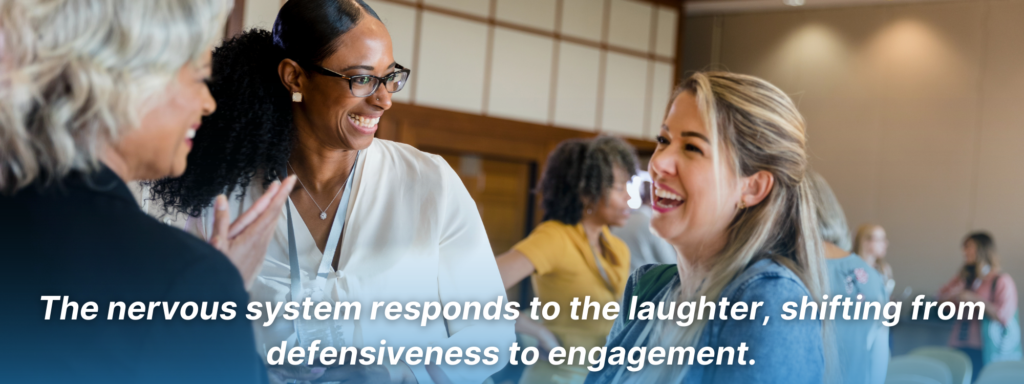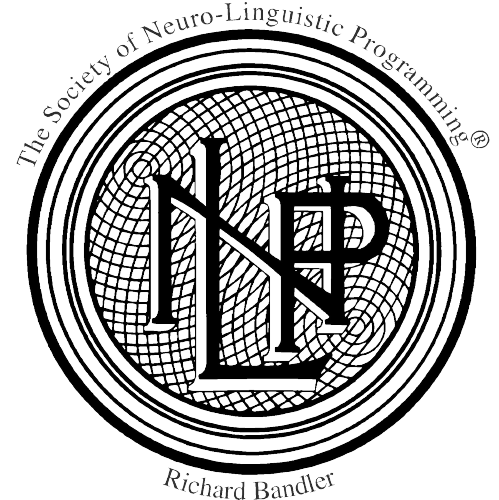Humour is often treated as a delightful aside, a bit of light relief in the midst of life’s seriousness. Yet, beneath its surface, humour carries profound power. It is not merely entertainment; it is connection, defiance, and sometimes even salvation. Across cultures and centuries, laughter has bridged divides, eased tensions, and fostered understanding.
But what if humour’s capacity to connect went even deeper? What if it could reach into the autonomic nervous system itself, disarming fear, inviting trust, and restoring balance?
This is the idea at the heart of Co-Regulating Humour (CRH), an approach that draws on:
- Stephen Porges’ Polyvagal Theory, which revolutionised the understanding of the autonomic nervous system’s response to cues of safety, danger and life threat. It shapes our emotions, behaviours and relationships. It underscores the importance of creating environments that foster safety and co-regulation, allowing people to have fulfilling lives.
- Richard Bandler’s several human change technologies, the most notable being Neuro-Linguistic Programming (NLP). His work is influential worldwide, exploring the connections between language, thought, and behaviour to unlock human potential. In his work, Bandler combines his formidable verbal and non-verbal skillsets with his keen comedic talent to create lasting transformations for an array of mental and emotional maladies.
Together, they form a foundation for understanding how humour can be used intentionally—not for just for comedic genius but, for the rest of us mere mortals, for creating safety, encouraging resilience, and inspiring transformation.

The Science of Safety
Polyvagal Theory offers a radical lens through which to view human behaviour. It reveals that our autonomic nervous system is not a mere on-off switch between calm and panic but a sophisticated network tuned to cues of safety and danger. This system works constantly and unconsciously, scanning the environment for signs of threat or reassurance—a process Porges calls ‘neuroception’.
When safety is detected, the social engagement system comes online, enabling trust, collaboration, and connection. Without it, we retreat into defensive states like fight, flight, or freeze.
Now imagine humour as a signal of safety, like a friendly lighthouse cutting through a storm. Laughter tells the nervous system:
‘You’re not in danger. Relax. Engage.’
When used thoughtfully, humour can lower the heart rate, slow breathing, and gently nudge the nervous system out of its defensive crouch. It is a physiological handshake, saying, ‘You’re safe here.’
The Playful Mind
If Polyvagal Theory explains the ‘why’ of Co-Regulating Humour, NLP offers the ‘how’. Dr Richard Bandler’s work on language and perception demonstrates how our thoughts and emotions can be restructured through playful engagement. NLP practitioners use reframing to shift perspectives, much as a kaleidoscope rearranges coloured fragments into new patterns.
Humour, when aligned with NLP principles, amplifies this effect. Consider the power of playful exaggeration. When someone says, ‘I always mess things up,’ a coach might respond, ‘Always? Even when tying your shoelaces? That’s impressive consistency!’
The absurdity invites the person to reconsider their belief. This gentle contradiction creates space for change. It’s not about mocking but about showing, with a smile, that what feels immovable is often just a shadow on the wall.

The Practical Wisdom of Humour
The elegance of CRH lies in its simplicity. To make humour work as a tool for co-regulation, one doesn’t need to be a comedian. In fact, it’s better if you’re not. Instead, the goal is to cultivate an attitude of playful curiosity. Why? Because playfulness slows breathing, and slower breathing fosters safety. Safety, in turn, opens the door to connection and creativity.
Take the example of a leader addressing a team about a daunting project. A simple remark like:
‘Don’t worry, this isn’t another corporate PowerPoint marathon… unless that’s your idea of a good time!’
Such small moments are enough to transform anxious niggles into shared giggles. The nervous system responds to the laughter, shifting from defensiveness to engagement. It’s as if the room itself exhales.
But the power of CRH extends beyond defusing tension. Humour reframes challenges in ways that unlock resilience and innovation. A tight deadline becomes an ‘epic quest’. A heated disagreement becomes an opportunity for ‘creative sparring’. The laughter doesn’t erase the difficulty, but it alters how the difficulty is experienced. It reframes fear as possibility.
Beyond Stress Relief
It’s tempting to view laughter as mere stress relief, a momentary release valve. Yet, its effects ripple far further. Laughter lowers cortisol, the stress hormone, and releases endorphins, those natural mood elevators. In groups, shared laughter builds bonds, creating a collective sense of:
‘We can handle this’
This is particularly evident in leadership. A leader who uses humour to navigate tension doesn’t just reduce stress—they strengthen cohesion. They remind their team of their shared humanity. Imagine a tense meeting where stakes are high, and tempers are fraying. A leader who interjects with a self-deprecating quip or a light-hearted observation about the absurdity of the situation can shift the emotional tide entirely. The laughter they spark isn’t trivial; it’s transformative.
The Limits of Seriousness
There is a paradox here. Many leaders and professionals believe seriousness conveys authority, while humour undermines it. Yet, the opposite is often true because, if you’re too being too serious, you’re being too serious. Excessive seriousness creates disconnection, ruptures safety and feels like a closed door. While humour invites people in by triggering their innate impulse to approach and connect. It says:
‘I’m human too and we’re better together.’
Humour also disrupts rigidity—the enemy of creativity. In therapy or leadership, playful challenges spark ideas that wouldn’t emerge from formal discussions. Asking a team, ‘What’s the most ridiculous solution to this problem?’ may seem frivolous, but it often leads to breakthroughs. Why? Because laughter frees the mind to wander and imagine, unshackled by fear of failure.

Building Bridges with Laughter
Ultimately, CRH is about connection. It draws on the wisdom of Polyvagal Theory to remind us that safety is the foundation of all human interaction. It uses the tools of NLP to show us how humour can reframe and reimagine our experience of the world. And it calls us to embrace playfulness as a bridge—one that spans the divide between fear and trust, rigidity and creativity, isolation and belonging.
In a world that feels increasingly divided and anxious, the simplicity of Co-Regulating Humour is a quiet revolution. It doesn’t demand perfection, nor does it rely on formal expertise. It simply asks us to play, to notice the absurd, and to laugh together. From the a coaching session to the boardroom, CRH invites us to use laughter, not as an escape, but as an entry point—a way of saying:
‘Let’s figure this out. Together.’
Ready to unlock the quiet power of humour? Whether you’re leading a team, coaching clients, or navigating life’s challenges, laughter can transform connection, build trust, and spark resilience.
Start small—begin with your attitude by cultivating a more jovial demeanour. Practice with playful remarks to reframe a challenge with a light-hearted twist. Notice how the energy shifts.
Curious to learn more? I shall be producing more material diving into the art of Co-Regulating Humour, allowing you to discover how to turn every smile into a bridge to emotional safety, psychological permission, group cohesion, creativity, and collaboration.
Let’s create connection—one laugh at a time.



